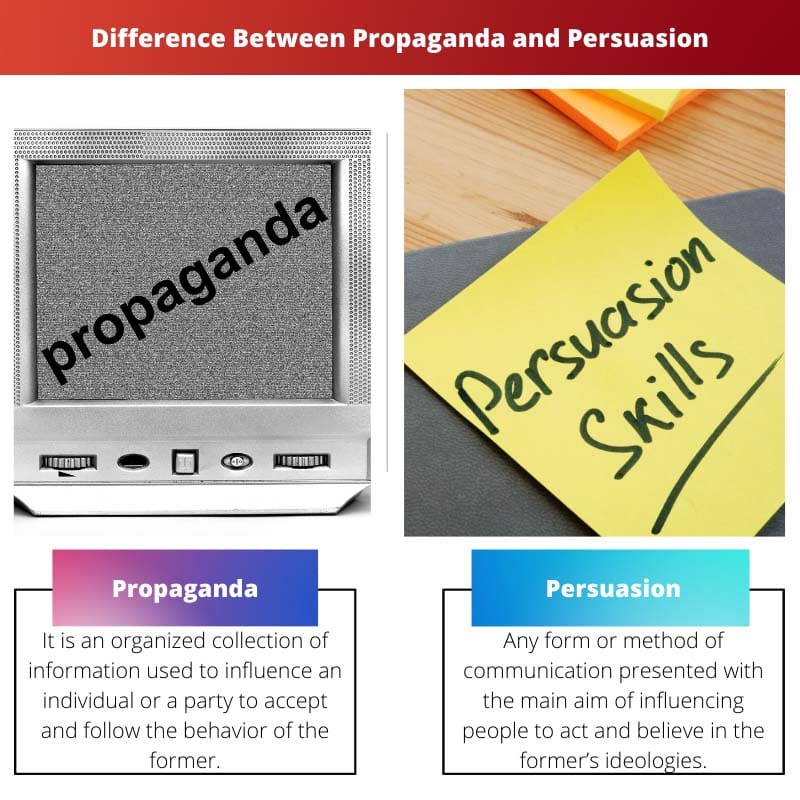To get someone to think or act in a particular desired way, one can use two tactics, namely propaganda and persuasion. Though these two seem to be similar to each other, they are different.
These two methods differ in terms of the means and style of communication. They also differ in the process of communication, including transmission and response.
Key Takeaways
- Propaganda uses communication techniques to influence people’s beliefs or opinions, with an agenda or political motive. In contrast, persuasion uses logical arguments and emotional appeals to convince someone to do or believe something.
- Propaganda uses deceptive or manipulative tactics, while persuasion relies on building trust and presenting convincing evidence.
- Propaganda is associated with negative connotations, while persuasion can be used for positive and negative purposes.
Propaganda vs Persuasion
Propaganda is a communication technique used to convince someone. There are three types of propaganda. Persuasion is a technique used to convince someone through logical arguments. The main focus of persuasion is to build trust. Evidence can be provided to convince people in persuasion. There are three segments of persuasion.

Propaganda refers to a well-organized form of communication in which the person has a strong aim to convince the party to act or think alike and to carry their interests in an intended field or concept. The party is reinforced to act favourably to the individual or the party who likes propaganda.
Persuasion refers to the method by which the former party tries to influence the other party strongly. Based on Aristotle’s study of persuasion has three stages which are ethos, logos, and also pathos.
In other words, it is called a simple interaction between the two parties. Generally, it is considered to be a two-way process.
Comparison Table
| Parameters of Comparison | Propaganda | Persuasion |
|---|---|---|
| Definition | It is an organized collection of information used to influence an individual or a party to accept and follow the behavior of the former. | Any form or method of communication presented with the main aim of influencing people to act and believe in the former’s ideologies and thoughts. |
| Types | It is of three categories which are black, gray, and white propaganda. | Aristotle classified the process into three segments. Ethos – persuading with trust and credibility, logos – persuading using reasoning and logical skills, pathos- persuading by targeting the emotional level. |
| Flow and Control | The information is monitored and controlled by the propagandist. | The information flows at ease between the persuader and the persuadee. |
| Communicators’ Nature | It occurs between groups and institutions, informal cases. | It might occur in three cases, between individuals, between a group and an individual, or between two groups. |
| Benefits | In maximum cases, only the propagandist gets benefitted, and in some rare cases, the recipient gets benefitted as well. | It is benefitted by both the parties since they continue with good terms throughout the process. |
What is Propaganda?
It is a technique of influence and lures the audience. Facts are arranged in order with an agenda aiming at acquiring gain and support by trying and reaching the party or the individual at the emotional level.
It is in use in the areas of governments, institutions, and religious places. Though it is considered a manipulative method, it is neutral descriptive.
To convey and communicate the propaganda’s information and details. The messages are propagated through a lot of platforms which are constantly varying due to the new development in technology.
It might also include biased and fallacious information. Controversial messages are also propagated. It also conveys information through manipulation and enforcement.
It is regarded as an event that is regarded and carried on with persistence and arduous effort to influence and convince people. It is the event in which a party attempt to control behaviours.
It is also an objective and systematic method. It is also a means of communication in which ideologies and messages and conveyed. It is done in a strongly influential and as an activity that benefits the propagandist majorly.

What is Persuasion?
It is the act or process of conveying and convincing a party to change their opinions, thoughts, and ideologies favourable to yours. Persuasion is a version of motivation that involves a lot of force and influence to bring about the desired changes.
It is a way of presenting arguments to change the ideas and opinions of the other party.
Some examples are the powerful and strong writings of Aristotle. His speech also includes a lot of persuasive phrases and statements. Another good example is President Obama, who is a very good persuade with his thoughtful speeches. Some daily life examples include our day-to-day events.
For example, if we would like to go on a night out with our friends, there would be a lot of persuading needs to be done with our parents.
It is quite a tactful thing to convince other people, make them agree with your ideologies, and enforce a change in them so that they start seeing things from your point of view.
One popular example is sales, the way in which the salesperson convinces the customer to purchase a product is also persuasion.

Main Differences Between Propaganda and Persuasion
- Propaganda is an organized collection of information and communication of it, whereas persuasion can be of any form.
- Propaganda is classified into three types, whereas persuasion is classified into three segments.
- The propagandist holds control during the propagation, but the persuader does not hold the control.
- Propaganda occurs between groups and parties, whereas persuasion might also occur between individuals.
- Usually, only the propagandist takes benefits, whereas, in persuasion, both parties share almost equal benefits.

- https://journals.sagepub.com/doi/abs/10.1177/0392192107087916
- https://www.taylorfrancis.com/chapters/edit/10.4324/9781315850979-36/propaganda-persuasion-contemporary-conflict-david-miller-piers-robinson-vian-bakir

The categorization of propaganda and the three types of persuasion by Aristotle make for an insightful read. The analysis of the communicators’ nature and benefits of both methods illustrates their varying impact.
The description of propaganda and persuasion is comprehensive, shedding light on their distinct processes and effects. The article effectively explores the means of conveying both techniques.
The detailed differentiation between propaganda and persuasion provides valuable knowledge. The systematic method and strong influence of persuasion are crucial aspects in understanding its dynamics.
The segment on what constitutes propaganda is enlightening, highlighting the use of emotional appeals and the varied platforms employed for its communication. The portrayal of persuasion as a version of motivation underscores its significance in influencing change.
Understanding the parameters of comparison between propaganda and persuasion offers valuable insights. It’s crucial to be discerning when exposed to different forms of communication.
The comparison table presents a structured analysis of propaganda and persuasion, emphasizing their definitional disparities. The event-based nature of propaganda and the forceful aspect of persuasion are thought-provoking.
The informative breakdown of propaganda and persuasion is instrumental in discerning the intended influence behind various forms of communication. The article effectively captures the essence of these communication techniques.
The article delivers a thorough understanding of what constitutes propaganda and persuasion. The examples provided further enhance the comprehension of these communication methods.
The concept of persuasion as a means of changing opinions and ideas through forceful influence is well articulated. The examples of persuasive figures such as Aristotle and President Obama further elucidate the nature of persuasion.
The article provides a clear and concise distinction between propaganda and persuasion. It is important to understand the differences between the two in order to decipher the intentions behind certain messages or communication methods.